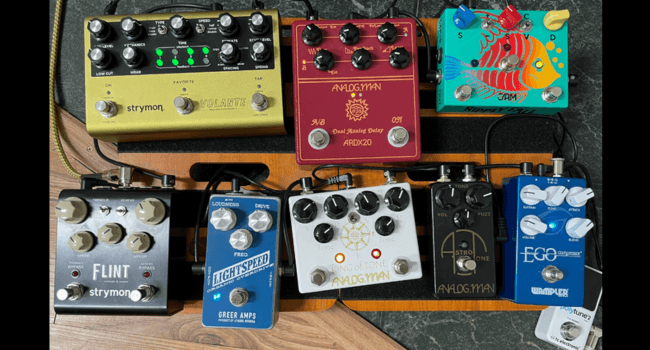
Demystifying Coil Cutting, Splitting, & Tapping
Untangling Your Tones: The Truth Behind Coil Cutting, Splitting, and Tapping
If you've ever delved into the world of guitar pickups, you've likely encountered "coil cutting," "coil splitting," and "coil tapping." Lots of folks assume that these terms are used interchangeably to refer to the same thing… which is only partially true.
While they all aim to modify your humbucker's output and expand your tonal palette, they achieve this in subtly different ways. Let's demystify these techniques to help you better understand how each one can shape your sound.
Note that at the heart of this discussion is the humbucker. For those not in the know, a humbucker typically consists of two coils wired in series together, but out of phase to "buck" or cancel out 60-cycle hum. The techniques we're discussing today essentially manipulate these two coils with the goal of achieving a sound approaching a single-coil or something altogether unique.
Coil Splitting: The Most Common Tone Trick

Coil splitting is arguably the most prevalent of these modifications. When you "split" a humbucker, you are effectively switching one its coils off and leaving the other coil active.
-
How it works: commonly, coil splitting is achieved with a push/pull pot or a mini-toggle switch that disconnects the traditional “hot” lead of the humbucker and sends the series link to the front (aka your switch or volume)
-
The sound: The resulting tone is a brighter, lower-output sound that mimics a single-coil pickup. While it won't be an exact replica of a true single-coil (due to differences in winding, magnet type, and overall construction), it gets you into that spankier, more articulate territory - fantastic for achieving cleaner tones, more chime, and a less compressed feel than a full humbucker.
-
Why use it? Versatility! A guitar with coil-splittable humbuckers can cover a much wider range of musical styles, allowing you to go from thick, distorted rock tones to crisp, clean funk sounds with the flick of a switch.
Coil Cutting: A Close Relative, but Distinctly Different

Coil cutting is often used interchangeably with coil splitting, and in many practical applications, the outcome can be similar. However, there's a subtle but important distinction in how it's achieved.
-
How it works: Instead of completely deactivating one coil (as in splitting), coil cutting often involves routing the series link to ground, effectively "cutting" the coil behind the series link.
-
The sound: Similar to coil splitting, the aim is to reduce the pickup’s output and change its tonal character, often pushing it towards a more single-coil-like sound. The exact result can vary depending on how the "cut" is implemented.
-
Why the confusion? Because the end result (a more single-coil-like tone from a humbucker) is so similar to coil splitting, the terms often get confused. However, true coil splitting disconnects a coil, while true coil cutting shorts out a coil.
Coil Tapping: A Specialized Approach

While the term "coil tapping" is traditionally associated with single-coil pickups (where it refers to accessing different physical points along the coil windings to achieve variances in the pickup’s output), for humbuckers, "coil tapping" refers to a distinct method of tone shaping.
-
How it works: In the specific context of humbucking pickups, "coil tapping" involves strategically using passive components like a capacitor or a resistor to limit or attenuate the output of one of the humbucker's coils. Electronically modifying its contribution to the overall signal.
-
The sound: The goal of this method is to shape the sound of the humbucker to a sound somewhat similar to a single-coil sound, but with a crucial advantage: retaining the hum-cancelling properties of the humbucker. By attenuating rather than completely deactivating one coil, both coils remain active in the circuit, allowing them to continue their humbucking function. This offers a nuanced tonal shift, providing clarity without introducing the 60-cycle hum often associated with true single-coil operation.
-
Why use it? This technique offers a unique balance – the tonal clarity and brightness approaching a single-coil, but with the quiet operation of a humbucker. It's a method for achieving more subtle tonal variations and fine-tuning the balance between the two coils without fully committing to a hum-prone single-coil mode. It's way less common than coil splitting, often found in custom wiring or High-end boutique instruments designed for specific tonal versatility.
Summary: Your Tonal Toolkit
|
Feature |
Coil Splitting |
Coil Cutting |
Coil Tapping |
|---|---|---|---|
|
Pickup Type |
Humbuckers |
Humbuckers (less common as a distinct term) |
Humbuckers (specialized wiring) |
|
Mechanism |
Disconnects the traditional hot and send the series link to the front |
Sends the series link to ground. Cuts the coil after the series link. |
Capacitor/resistor to attenuate the coil behind the series links output |
|
Result |
Single-coil-like tone, lower output, brighter |
Similar to splitting, often confused with it |
Brighter, more articulate tone; retains hum-cancelling properties |
|
Purpose |
Versatility, single-coil sounds from humbuckers. |
Tonal variation, often similar to splitting |
Nuanced tonal shaping with hum-cancellation intact |

Understanding these distinctions empowers you to make informed decisions about your guitar's electronics. Whether you're chasing that glassy single-coil chime or dialing in a roaring humbucker crunch, knowing the difference between coil cutting, splitting, and the specialized application of tapping will help you unlock the full sonic potential of your instrument.
Experiment with these options, and happy playing!




2 comments
Hi Eric, we don’t have audio available at the moment. It is challenging to generalize a “sound” in this context due to the significant influence of the overall pickup. For example, splitting and cutting a balanced coiled humbucker would result in a relatively minor change. However, a mismatched set of coils could produce a slightly more dramatic or noticeable effect. Designers tend to use these circuits on a case-by-case basis.
Sean@Gunst
Series Link is a new term to me. Great article really help me wrap my head around what’s happening with split cut and tap. Do you have examples anywhere of “Front” and “Ground” where the signal is sent that are audible? Thanks I have a Tele harness and an LP harness from you both to be installed.
Eric Shelsy
Leave a comment
This site is protected by hCaptcha and the hCaptcha Privacy Policy and Terms of Service apply.